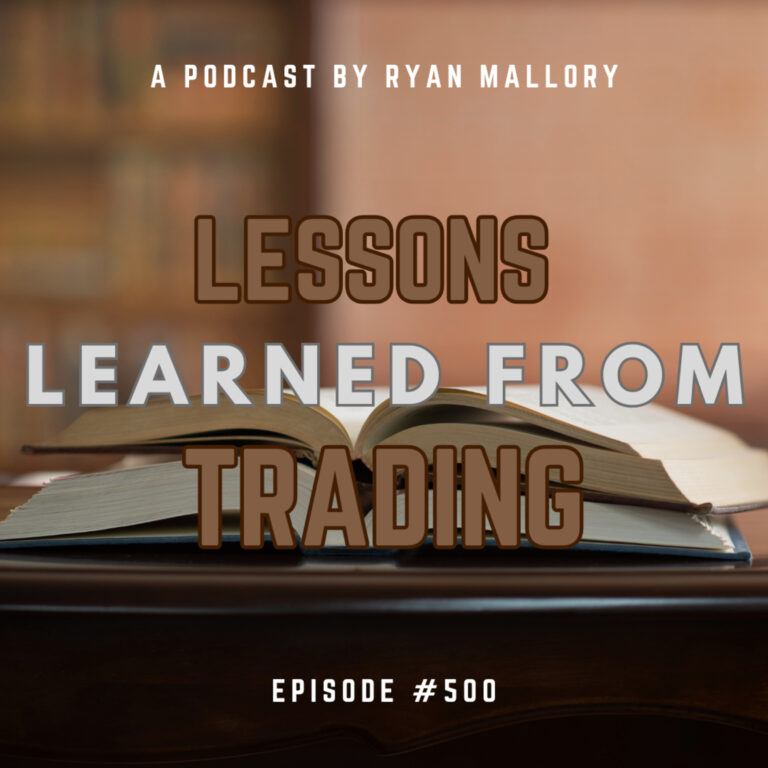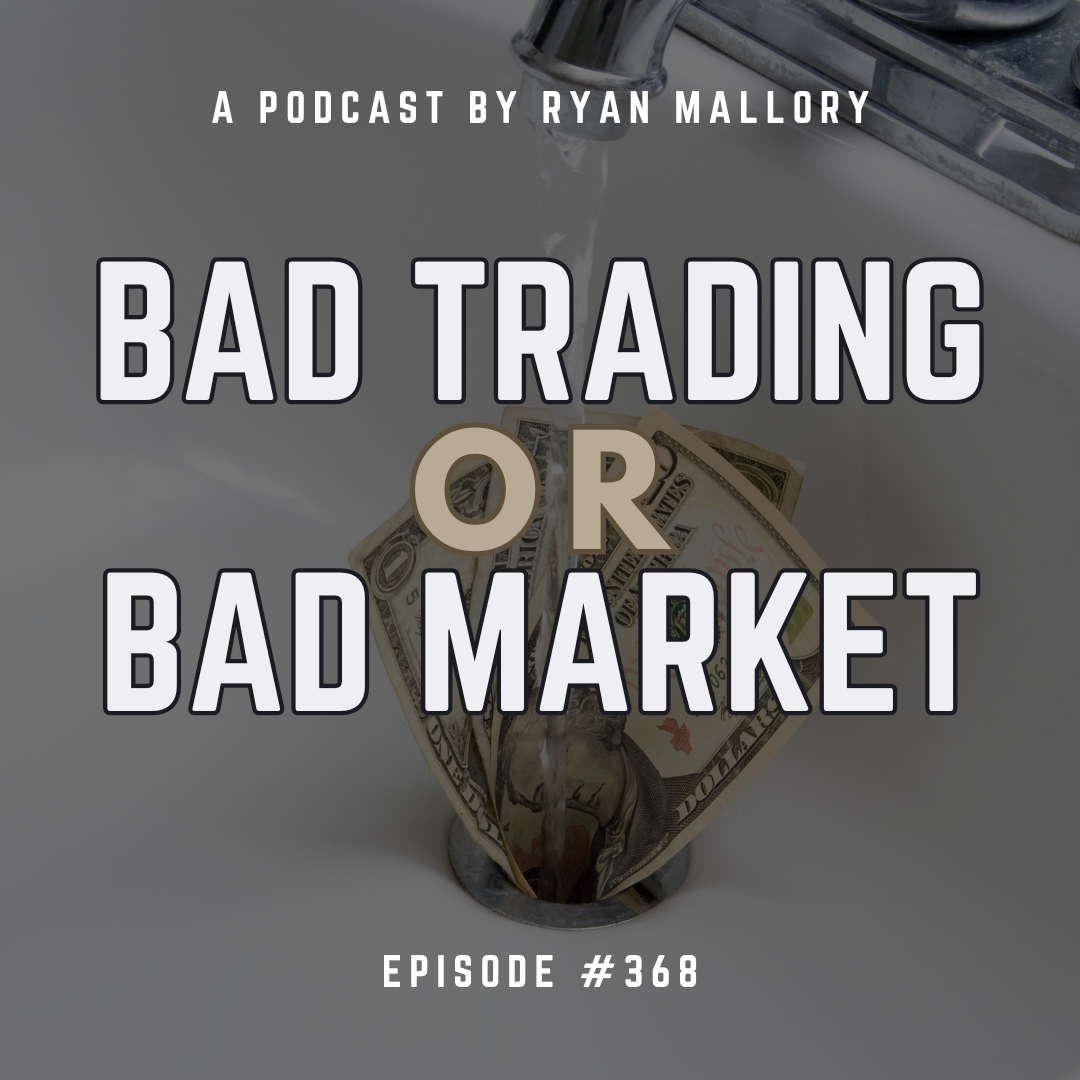Episode Overview
When you chart out your technical analysis and the trade setup has a promising reward risk ratio, along with solid support underneath, you’ve planned out where to put the stop-loss and you simply just feel good about the trade, but then everything goes wrong on the trade and you find yourself getting quickly stopped out. What was that the result of? Bad technical analysis, or a market that wasn’t conducive to the trade working out?
Available on: Apple Podcasts | Spotify | Amazon | YouTube
Episode Highlights & Timestamps
- [0:07] Introduction to the Topic
Ryan explores how to discern whether poor technical analysis or rough market conditions are to blame for losing trades. - [1:26] Listener Question from Virgil
A trader from Saskatchewan asks how to tell if losing trades are due to faulty technical analysis or unpredictable market behavior. - [2:12] Understanding the Role of Technical Analysis
Ryan emphasizes that technical analysis is about gaining an edge, not offering guarantees, and discusses how losing trades are inevitable even with good setups. - [4:18] Unpredictability of Markets
Global events, earnings reports, and psychological influences are explored as factors that disrupt even the best technical setups. - [10:18] Tools, Risk Management, and Adapting
Highlights the importance of platforms like TC2000 and why consistent execution and proper risk management are crucial for long-term success.
Key Takeaways from This Episode:
- Edge Over Guarantees: Technical analysis doesn’t promise results but provides a probability edge. Losing trades are part of the process.
- Don’t Ignore Risk Management: Using stop losses is essential for managing unpredictability and protecting your portfolio.
- Stay Consistent in Your Analysis: Applying your TA rules selectively will skew results. Respect both resistance and support.
- Emotions and Bias Impact Trades: Fear, greed, or political views can distort your decisions. Detachment from bias leads to better trading discipline.
- Invest in the Right Tools: Accurate charting platforms like TC2000, TradingView, or TrendSpider can make a big difference in performing quality analysis.
Resources & Links Mentioned:
- Swing Trading the Stock Market – Daily market analysis, trade setups, and insights by Ryan Mallory.
- Join the SharePlanner Trading Block – Get real-time trade alerts and community support.

Take the Next Step:
✅ Stay Connected: Subscribe to Ryan’s newsletter to get free access to Ryan’s Swing Trading Resource Library, along with receiving actionable swing trading strategies and risk management tips delivered straight to your inbox.
📈 Level Up Your Trading: Ready for structured training? Enroll in Ryan’s Swing Trading Mastery Course, The Self-Made Trader, and get the complete trading course, from the foundational elements of trading to advanced setups and profitable strategies.
📲 Join the Trading Community: Sign up for SharePlanner’s Trading Block to become part of Ryan’s swing-trading community, which includes all of Ryan’s real-time swing trades and live market analysis.
Full Episode Transcript
Click here to read the full transcript
0:07
Hey, I’m Ryan Mallory and this is my Swing Trading the Stock Market podcast. I’m here to teach you how to trade in a complex, everchanging world of finance. Learn what it means to trade profitably and consistently managing risk, avoiding the pitfalls of trading, and most importantly, to let those winners run wild.
0:25
You can succeed at the stock market and I’m ready to show you how. Hey everybody, this is Ryan Mallory with Swing Trading the stock Market. In today’s episode, we’re going to talk about technical analysis and how to know when it’s poor technical analysis that’s causing us to lose on a trade or if it’s just poor market conditions that we were entering our trade into.
0:48
In today’s e-mail, we are going to call this individual who emailed the show Virgil, like try to give people a good Florida redneck name and Virgil rights. Hey Ryan, guy from a small town, Saskatchewan here. Take my time trying to say that name because that is not the easiest thing for me to say.
1:06
So any case, the guy from Saskatchewan continues by saying I’ve been learning and watching the stock market for three years now and have been trading officially for one year. It’s been going well so far, no major losses and mostly small wins. My question is, I use the candlesticks, fib sequences and volume when a trade doesn’t go as planned.
1:26
I don’t know if that’s just the market doing its thing, proving people wrong, or if I’m not doing my technical analysis correctly. Have you ever felt this way? And so how do you differentiate between poorly done technical analysis and market conditions?
1:41
Sincerely, new subscriber, that places you in the top five of most helpful resources online. Well, First off, thank you for considering me as one of your favorite resources online. That does mean a lot cuz I put a lot of blood, sweat and tears into this thing.
1:56
I’m really trying to make a difference in the financial community and how people trade, so I do appreciate that. Now as to your question, I think there’s a lot to digest and we’re going to go over. I’m going to hit a number of different points here in this podcast episode, but I think it all boils down to what is technical analysis?
2:12
Is technical analysis an edge and your trading or is it a guarantee? Now right off the bat we hear the word guarantee. We know there’s no such thing as a guarantee and trading, so it has to be an edge. And when you have an edge, you have a favorable probability of something happening.
2:30
Maybe it’s only like 51% chance of you being right on the trade. That’s still an edge. It’s better than 49. It’s it’s an edge over being 49% probability. Or it’s a probability that says, hey, maybe I only have a 33% chance of being right, but based off of the system, when I’m right, it outpaces my losses on the other 66% of my trades by 12:50.
2:56
That’s an edge too. So it doesn’t have to necessarily be based off a winning percentage. It can also be based off a reward to risk. And usually those things go hand in hand very closely and are both critical and determining whether or not you have an edge. And without getting into all those particular details, the reason why I bring that up the edge versus the guarantee is because at times when we’re doing technical analysis, even some of the best technical analysis, we’re going to have losing trades.
3:21
It’s part of it. And so if you go on a string of losing trade, that’s really easy to start doubting yourself and saying, man, I don’t know what I’m doing. And trust me, I have that all the time. I see things happening in the market. I’m like, whoa, I did not see that one coming, Don’t even know what the heck I’m doing sometimes.
3:37
And I genuinely do ask myself that, especially if I’m going through a losing streak or something, that’s starting to get under my skin a little bit. But the nature of the stock market is inherently unpredictable. Even the best technical analysis will not always be able to capture the inherent unpredictability of the market.
3:55
With all of our Martin tools, our knowledge, there’s still a level of unpredictability in the market and it’s impacted by so many different variables. We have economic reports that are coming out every morning. We have earnings reports that are coming up. We may not even be holding a particular stock through the earnings, but their earnings impact like, take Apple, can have reverberations throughout the entire stock market.
4:18
And then you have global events. You take this past weekend where Hamas attacked Israel. Did anybody have that on their bingo card when making decisions on Friday about whether or not to hold or sell over the weekend? Not me. I don’t think anybody did. Maybe Congress.
4:34
Congress seems to always be ahead of all this stuff. They’re like the most habitual offenders of insider trading I’ve ever seen. And then there’s also the psychological factors that are present in the market. Human psychology plays such an an important role. The fear and the greed will drive the market in ways that cannot be anticipated with technical analysis.
4:55
That’s why we have to have stop losses. If you listen to all my podcasts, I’d pretty much talk about stop losses in every episode because they’re so critical, because technical analysis will fail. And so there is limitations to technical analysis. And I’ve often said that when you’re looking at support levels and resistance levels, which are, you know, pretty much the most common elements of technical analysis, they’re not guaranteed to hold, but they are guaranteed to give you some direction.
5:19
And that’s what you’re trying to play off of. When a stock drops down to a key support level, maybe it’s a 10 year support level and you’re thinking to yourself it’s going to bounce and then it doesn’t. It goes right through that support level. What we shouldn’t be telling ourselves is that the technical analysis doesn’t work anymore. I’m done with this.
5:34
What we should be saying is that what is the technical analysis telling me? I understand how it can be personal. When you’re trying to play this rising trend line, you finally get this pull back to a key level. You’ve seen it bounce off of this rising trend line multiple times and as soon as you get in, it goes right through it. It’s frustrating and it can feel like the technical analysis doesn’t work, but instead what we should be looking at it from the framework of Okay.
5:56
It broke through it. Now was it telling us because the support level did not hold? That must mean that it’s a lot weaker than originally anticipated, that the sellers have a lot more control over the stock than what I’ve originally fathomed. And part of good technical analysis is going to be being consistent in how we apply it.
6:14
You have to apply it the same across the board. You can’t ignore key resistance levels overhead just because you want to get into the stock. You got to look at the fact that, hey, this is a key resistance level that’s really limiting the reward aspect of a reward risk trade set up. And it probably means that I shouldn’t get into the trade.
6:32
But if you go into like, I’m just going to assume that it’s going to break above that, then yeah, there’s a good chance you’re going to be disappointed. So if you’re going to ignore support and resistance, that’s one thing. If you’re going to ignore certain price patterns that have a bearish tilt to them when you’re so desperate to get long on a stock, yeah, that’s going to hurt you and your technical analysis.
6:51
And that comes back down to human folly, not so much the market doing that to you. But one thing I would tell you to check out is swingtradingthestockmarket.com. swingtradingthestockmarket.com is the website that goes alongside of this podcast. And in doing so, you’re going to get all of my stock market research each and every day.
7:12
So that’s going to include my weekly bearish and bullish watch list update. That’s also going to include my daily watch list of stocks I’m looking at potentially trading, plus updates on all the big tech stocks and on the S&P 500. You’re going to get multiple videos pretty much every day, so check that out.
7:29
You’re supporting this podcast in the process. Swing trading the-stockmarket.com. We talked about drilling in a recent episode and I think self evaluation and trying to find more ways to get better at your craft is incredibly important. If you’re not still learning, you’re not improving yourself.
7:46
If you’re not reflecting on your past trades, not just on your bad trades, but also on your good trades, then you’re not learning, you’re not improving either. And so you got to go back and you got to look at what you did wrong in those trades. I know so often times I can get caught up into a mindset that the markets should be doing this and I can start painting my outlook on certain trades and I have to be very careful of that.
8:09
That’s why I think a lot of times when people start mixing politics with their trades, that gets very difficult, that gets very difficult to win. And you’re seeing a lot of that with, for instance, Dewak, DWAC. And their political views are causing them to want to get into the stock or not consider the stock at all.
8:25
I mean, personally not considering the stock has been a pretty good approach over the years, But overall, people will get into it having a certain political agenda and then they realize it doesn’t play out that way in the stock market. The market really doesn’t care about your politics. And what we think about politics is rarely played out in the stock market.
8:43
So you want to keep that in mind. And so like I said, you know, going back and looking at your failures, what you did wrong. When a trade doesn’t go according to plan, ask yourself why. Was there overlooked indicators or something that you misinterpreted? Should you have taken some profits earlier on? Did you let fear and greed, like we just mentioned earlier, drive your trading decisions?
9:03
You can also have fear and greed in the market. You can’t really do nothing about that. We go back to when the market shut down in 2021 of the best examples of fear and greed. Within a 5-6 week period you had the fear of the economy shutting down. The market dropped like 30 plus percent. I mean it was just an absolute freefall that was fear.
9:20
And then all of a sudden the Fed bailed out the market drop rates to zero and did it just a crap ton of quantitative easing. And all of a sudden with all this liquid injection, you had a whole bunch of people buying. And so you went from extreme fear to extreme greed in a very short period of time.
9:41
Now, can technical analysis necessarily predict when you’re going to have those kind of rapid swings and emotion? No, but we do have to adapt to those kinds of scenarios. And there is an element of randomness. If you just sometimes look at you don’t apply any technicals to the chart and you just look at the chart for what it is, in many cases it’s going to look very, very random.
10:02
Yes, you might be able to spot some trends, but if you were to look at the XL U chart for instance, over the last three years prior to the recent breakdown, it just looks random. It looks random, but using technical analysis, you’re able to see that there’s a topping pattern that was forming over those years. And so when it broke down, it made a little bit more sense.
10:18
And so that’s what technical analysis is trying to do. There is trying to take what looks like randomness at times and create sense out of it. Try to make for a possible edge and trading. That’s why you see me drawing trend lines and diagramming risk and reward and support and resistance and of course risk management.
10:36
It’s going to come down to that as well. That’s such a huge part of one’s trading is how are they managing the risk? Are they limiting the losses? You have to limit your losses because when technical analysis doesn’t go right for you, when support doesn’t hold like you think that it should. Or if you’re playing a breakout of resistance and it doesn’t happen and price is rejected or we get a head faked on that we have to have some kind of risk management mechanism in place in order to limit our losses.
11:03
Because for instance, you know I, I traded F&D not too long ago, it was a rising trend line, looked really good that bounced off of it, this trend line multiple times. And then I I play the pullback and it tests it starts to bounce a little bit and then just completely falls apart.
11:19
Now, if I held on, I’d be taking a much bigger loss than the three or 4% that I took on that trade. That’s why you need the stop losses because no matter how good your TA is, your technical analysis you’re going to have losing trades. And when you get stopped out of a trade, you need a manner essentially technical analysis is trying to draw the line in the sand for you.
11:38
That trend line that I got stopped out of on F&D was the line in the sand. If it crosses below that, I don’t want to be in that stock anymore because it could get very very ugly as a result and did if I got into another one. Not too long ago DNUT made a good buck off of it. But when that trade was done and over with, I got stopped out for a profit and then it just completely fell apart.
11:59
And one of the things too to help yourself with technical analysis, like if you’re using your finger on your phone on thinker swimmers, it’s going to be hard to do good technical analysis. It’s good to invest in a trading platform. I use TC2000. I think trading view is also pretty good, Trend spiders pretty good. But TC2000 is my favorite.
12:15
I can draw trend lines very good, very accurately and that’s important as well. So having the right tools in place is going to make a big impact as well on one’s trading. If you enjoyed this podcast episode, I would encourage you to leave me a 5 star review on whatever platform you’re listening on, whether it’s Amazon, Spotify, Spotify is my favorite that you got Apple as well as whatever you’re listening to.
12:38
Leave me a 5 star review. I appreciate that very much and keep sending me your questions. ryan@shareplanner.com I appreciate Virgil’s e-mail asking me about technical analysis. Remember it’s it’s about edge, not a guarantee. And check out swingtradingthestockmarket.com.
12:53
Thank you and God bless. Thanks for listening to my podcast, Swing Trading the Stock Market. I’d like to encourage you to join me in the SharePlanner trading block where I navigate the stock market each day with traders from around the world. With your membership you will get a seven day trial and access to my trading room, including alerts via text, e-mail and WhatsApp.
13:14
So go ahead, sign up by going to shareplanner.com/trading Block, that’s www.shareplanner.com/trading Block and follow me on SharePlanners, Twitter, Instagram and Facebook where I provide unique market and trading information every day. If you have any questions, please feel free to e-mail me at ryan@shareplanner.com.
13:34
All the best to you and I look forward to trading with you soon.
Enjoy this episode? Please leave a 5-star review and share your feedback! It helps others find the podcast and enables Ryan to produce more content that benefits the trading community.
Have a question or story to share? Email Ryan and your experience could be featured in an upcoming episode!
Become part of the Trading Block and get my trades, and learn how I manage them for consistent profits. With your subscription you will get my real-time trade setups via Discord and email, as well as become part of an incredibly helpful and knowledgeable community of traders to grow and learn with. If you’re not sure it is for you, don’t worry, because you get a Free 7-Day Trial. So Sign Up Today!

Welcome to Swing Trading the Stock Market Podcast!
I want you to become a better trader, and you know what? You absolutely can!
Commit these three rules to memory and to your trading:
#1: Manage the RISK ALWAYS!
#2: Keep the Losses Small
#3: Do #1 & #2 and the profits will take care of themselves.
That’s right, successful swing-trading is about managing the risk, and with Swing Trading the Stock Market podcast, I encourage you to email me (ryan@shareplanner.com) your questions, and there’s a good chance I’ll make a future podcast out of your stock market related question.
In today's episode, at episode 500, I am diving into the lessons learned from trading over the last 100 episodes, because as traders we are evolving and always attempting to improve our skillset. So here is to episode 500, and to another 500 episodes of learning and developing as swing traders in the stock market!
Be sure to check out my Swing-Trading offering through SharePlanner that goes hand-in-hand with my podcast, offering all of the research, charts and technical analysis on the stock market and individual stocks, not to mention my personal watch-lists, reviews and regular updates on the most popular stocks, including the all-important big tech stocks. Check it out now at: https://www.shareplanner.com/premium-plans
📈 START SWING-TRADING WITH ME! 📈
Click here to subscribe: https://shareplanner.com/tradingblock
— — — — — — — — —
💻 STOCK MARKET TRAINING COURSES 💻
Click here for all of my training courses: https://www.shareplanner.com/trading-academy
– The A-Z of the Self-Made Trader –https://www.shareplanner.com/the-a-z-of-the-self-made-trader
– The Winning Watch-List — https://www.shareplanner.com/winning-watchlist
– Patterns to Profits — https://www.shareplanner.com/patterns-to-profits
– Get 1-on-1 Coaching — https://www.shareplanner.com/coaching
— — — — — — — — —
❤️ SUBSCRIBE TO MY YOUTUBE CHANNEL 📺
Click here to subscribe: https://www.youtube.com/shareplanner?sub_confirmation=1
🎧 LISTEN TO MY PODCAST 🎵
Click here to listen to my podcast: https://open.spotify.com/show/5Nn7MhTB9HJSyQ0C6bMKXI
— — — — — — — — —
💰 FREE RESOURCES 💰
— — — — — — — — —
🛠 TOOLS OF THE TRADE 🛠
Software I use (TC2000): https://bit.ly/2HBdnBm
— — — — — — — — —
📱 FOLLOW SHAREPLANNER ON SOCIAL MEDIA 📱
*Disclaimer: Ryan Mallory is not a financial adviser and this podcast is for entertainment purposes only. Consult your financial adviser before making any decisions.





